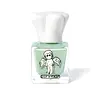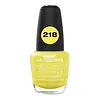What's inside
What's inside
 Key Ingredients
Key Ingredients

 Benefits
Benefits

 Concerns
Concerns

 Ingredients Side-by-side
Ingredients Side-by-side

Butyl Acetate
MaskingEthyl Acetate
PerfumingNitrocellulose
Acetyl Tributyl Citrate
MaskingTrimellitic Anhydride
Isopropyl Alcohol
SolventStearalkonium Hectorite
Gel FormingAdipic Acid/Fumaric Acid/Phthalic Acid/Tricyclodecane Dimethanol Copolymer
Citric Acid
BufferingIron Oxides
CI 77491
Cosmetic ColorantCI 15880
Cosmetic ColorantCI 15850
Cosmetic ColorantCI 19140
Cosmetic ColorantCI 77510
Cosmetic ColorantMica
Cosmetic ColorantCI 42090
Cosmetic ColorantCI 60725
Cosmetic ColorantCI 77891
Cosmetic ColorantCI 77007
Cosmetic ColorantCI 45410
Cosmetic ColorantCI 45380
Cosmetic ColorantCI 47005
Cosmetic ColorantBis(Glycidoxyphenyl)Propane/Bisaminomethylnorbornane Copolymer
CI 77000
Cosmetic ColorantPolyethylene Terephthalate
Polybutylene Terephthalate
Styrene/Acrylates Copolymer
Ethylene/Va Copolymer
Emulsion StabilisingButyl Acetate, Ethyl Acetate, Nitrocellulose, Acetyl Tributyl Citrate, Trimellitic Anhydride, Isopropyl Alcohol, Stearalkonium Hectorite, Adipic Acid/Fumaric Acid/Phthalic Acid/Tricyclodecane Dimethanol Copolymer, Citric Acid, Iron Oxides, CI 77491, CI 15880, CI 15850, CI 19140, CI 77510, Mica, CI 42090, CI 60725, CI 77891, CI 77007, CI 45410, CI 45380, CI 47005, Bis(Glycidoxyphenyl)Propane/Bisaminomethylnorbornane Copolymer, CI 77000, Polyethylene Terephthalate, Polybutylene Terephthalate, Styrene/Acrylates Copolymer, Ethylene/Va Copolymer
Butyl Acetate
MaskingEthyl Acetate
PerfumingNitrocellulose
Phthalic Anhydride/Trimellitic Anhydride/Glycols Copolymer
Acetyl Tributyl Citrate
MaskingIsopropyl Alcohol
SolventStearalkonium Hectorite
Gel FormingCitric Acid
BufferingTitanium Dioxide
Cosmetic ColorantIron Oxides
CI 19140
Cosmetic ColorantCI 47005
Cosmetic ColorantCI 42090
Cosmetic ColorantCI 77007
Cosmetic ColorantCI 15850
Cosmetic ColorantCI 15880
Cosmetic ColorantMica
Cosmetic ColorantCI 77510
Cosmetic ColorantCI 77742
Cosmetic ColorantButyl Acetate, Ethyl Acetate, Nitrocellulose, Phthalic Anhydride/Trimellitic Anhydride/Glycols Copolymer, Acetyl Tributyl Citrate, Isopropyl Alcohol, Stearalkonium Hectorite, Citric Acid, Titanium Dioxide, Iron Oxides, CI 19140, CI 47005, CI 42090, CI 77007, CI 15850, CI 15880, Mica, CI 77510, CI 77742
Ingredients Explained
These ingredients are found in both products.
Ingredients higher up in an ingredient list are typically present in a larger amount.
Acetyl Tributyl Citrate is a fragrance.
We don't have a description for Butyl Acetate yet.
Ci 15850 is the pigment color red. It is an azo dye and created synthetically.
Azo dyes need to be thoroughly purified before use. This allows them to be more stable and longer-lasting.
This ingredient is common in foundations, lipsticks, and blushes. This color is described as brown/orangey red.
It has many secondary names such as Red 6 and Red 7. According to a manufacturer, Red 6 usually contains aluminum.
Learn more about CI 15850We don't have a description for CI 15880 yet.
CI 19140 is also known as Tartrazine. Tartrazine is a synthetic dye used in cosmetics, foods, and medicine to add a yellow color.
Tartrazine is created from petroleum and is water-soluble.
Some people may experience allergies from this dye, especially asthmatics and those with an aspirin intolerance.
Learn more about CI 19140Ci 42090 is a synthetic dye created from petroleum. It is used to give a bright blue color to cosmetics, medicine, and food.
This ingredient, also known as Quinoline Yellow, is a water-soluble dye. It is a yellow/yellow-brown powder.
This pigment is called Ultramarine blue lazurite. It gives a saturated blue color, but can be used to create other colors as well.
According to the manufacturer, it is usually made from kaolin, sodium sulfate, sodium carbonate, sulfur, and charcoal.
This ingredient is used to impart a blue color. It is not water-soluble.
It goes by two different names:
1. Ferric Ferrocyanide: a synthetic dark blue pigment
2. Ferric Ammonium Ferrocyanide: a synthetic blue pigment, also called Prussian blue
In the EU, both of these colors must be labeled as 'CI 77510'.
Learn more about CI 77510Citric Acid is an alpha hydroxy acid (AHA) naturally found in citrus fruits like oranges, lemons, and limes.
Like other AHAs, citric acid can exfoliate skin by breaking down the bonds that hold dead skin cells together. This helps reveal smoother and brighter skin underneath.
However, this exfoliating effect only happens at high concentrations (20%) which can be hard to find in cosmetic products.
Due to this, citric acid is usually included in small amounts as a pH adjuster. This helps keep products slightly more acidic and compatible with skin's natural pH.
In skincare formulas, citric acid can:
While it can provide some skin benefits, research shows lactic acid and glycolic acid are generally more effective and less irritating exfoliants.
Most citric acid used in skincare today is made by fermenting sugars (usually from molasses). This synthetic version is identical to the natural citrus form but easier to stabilize and use in formulations.
Read more about some other popular AHA's here:
Learn more about Citric AcidEthyl Acetate is a fragrance.
Isopropyl Alcohol is more commonly known as rubbing alcohol. It is most commonly used as a solvent, meaning it helps other ingredients dissolve.
This ingredient is an astringent alcohol. Astringent alcohols may also irritate skin as they high amounts may strip away your skin's natural oils.
Other types of astringent alcohols include:
According to the National Rosacea Society based in the US, you should be mindful of products with these alcohols in the top half of ingredients.
Any type of sanitizing product will have high amounts of alcohol to help kill bacteria and viruses.
Learn more about Isopropyl AlcoholMica is a naturally occurring mineral used to add shimmer and color in cosmetics. It can also help improve the texture of a product or give it an opaque, white/silver color.
Serecite is the name for very fine but ragged grains of mica.
This ingredient is often coated with metal oxides like titanium dioxide. Trace amounts of heavy metals may be found in mica, but these metals are not harmful in our personal products.
Mica has been used since prehistoric times throughout the world. Ancient Egyptian, Indian, Greek, Roman, Aztec, and Chinese civilizations have used mica.
Learn more about MicaWe don't have a description for Nitrocellulose yet.
Stearalkonium Hectorite is a clay-derived ingredient used to thicken a product and help create a gel-like texture.
This ingredient is a combination of red, black, and yellow iron oxide pigments. This combination of colors is usually found in foundation, because it results in a "skin" color.